Recent Advances in Lossy Mode Resonance-Based Fiber Optic Sensors: A Review
Abstract
:1. Introduction
2. Basic Principle and Characteristics
2.1. Fundamentals
2.2. Resemblances and Differences between SPR and LMR
3. Geometrical Considerations
3.1. Straight Core Optical Fibers
3.2. Tapered Core Optical Fibers
3.3. U-Shaped Optical Fibers
3.4. D-Shaped Optical Fibers
4. Materials Supporting Lossy Modes for Sensing Applications
4.1. Indium Tin Oxide (ITO)
4.2. Indium Oxide (In2O3)
4.3. Zinc Oxide (ZnO)
4.4. Titanium Oxide (TiO2)
4.5. Tin Oxide (SnO2)
4.6. Polymers
4.7. Other Materials
5. Conclusions and Future Prospects
Author Contributions
Funding
Data Availability Statement
Acknowledgments
Conflicts of Interest
References
- Arregui, F.J.; Matias, I.R.; Goicoechea, J.; Villar, I.D. Optical fiber sensors based on nanostructured coatings. In Sensors Based on Nanostructured Materials; Arregui, F.J., Ed.; Springer: Berlin, Heidelberg, 2009; pp. 275–301. ISBN 978-1-4419-4601-0. [Google Scholar]
- Matias, I.R.; Ikezawa, S.; Corres, J. Fiber Optic Sensors: Current Status and Future Possibilities, 1st ed.; Springer International Publishing: Cham, Switzerland, 2017. [Google Scholar]
- Wei, L.; Tjin, S.C. Special Issue “Fiber Optic Sensors and Applications: An Overview”. Sensors 2020, 20, 3400. [Google Scholar] [CrossRef] [PubMed]
- Lee, B.; Roh, S.; Park, J. Current status of micro- and nano-structured optical fiber sensors. Opt. Fiber Technol. 2009, 15, 209–221. [Google Scholar] [CrossRef]
- Cusano, A.; Lpez-Higuera, J.M.; Matias, I.R.; Culshaw, B. Editorial optical fiber sensor technology and applications. IEEE Sens. J. 2008, 8, 1052–1054. [Google Scholar] [CrossRef]
- Lee, B. Review of the present status of optical fiber sensors. Opt. Fiber Technol. 2003, 9, 57–79. [Google Scholar] [CrossRef]
- Udd, E.; Spillman, W.B., Jr. Fiber Optic Sensors: An Introduction for Engineers and Scientists; John Wiley & Sons: Hoboken, NJ, USA, 2011. [Google Scholar]
- Kim, S.; Lee, J.; Jeon, H.; Kim, H.J. Fiber-coupled surface-emitting photonic crystal band edge laser for biochemical sensor applications. Appl. Phys. Lett. 2009, 94, 13–133503. [Google Scholar] [CrossRef]
- Ozcariz, A.; Zamarreno, C.R.; Arregui, F.J. A comprehensive review: Materials for the fabrication of optical fiber refractometers based on lossy mode resonance. Sensors 2020, 20, 1972. [Google Scholar] [CrossRef] [PubMed] [Green Version]
- Wolfbeis, O.S. Fiber-optic chemical sensors and biosensors. Anal. Chem. 2006, 78, 3859–3874. [Google Scholar] [CrossRef]
- Stewart, G.; Jin, W.; Culshaw, B. Prospects for fibre-optic evanescent-field gas sensors using absorption in the near-infrared. Sens. Act. B Chem. 1997, 38, 42–47. [Google Scholar] [CrossRef]
- Chan, K.; Ito, H.; Inaba, H. An optical-fiber-based gas sensor for remote absorption measurement of low-level CH4 gas in the near-infrared region. Journal of Lightwave Tech. 1984, 2, 234–237. [Google Scholar] [CrossRef]
- Wang, X.; Wolfbeis, O.S. Fiber-optic chemical sensors and biosensors (2015–2019). Anal. Chem. 2020, 92, 397–430. [Google Scholar] [CrossRef]
- Holst, G.; Mizaikoff, B. Chapter: Fiber optic sensors for environmental applications. In Handbook of Optical Fiber Sensing Technology, 1st ed.; John Wiley & Sons: Hoboken, NJ, USA, 2002. [Google Scholar]
- Dietrich, A.M.; Jensen, J.N.; da Costa, W.F. Chemical species. Water Environ. Res. 1996, 68, 391–406. [Google Scholar] [CrossRef]
- Schweizer, G.; Latka, I.; Lehmann, H.; Willsch, R. Optical sensing of hydrocarbons in air or in water using UV absorption in the evanescent field of fibers. Sens. Act. B Chem. 1997, 38, 150–153. [Google Scholar] [CrossRef]
- Mizaikoff, B.; Taga, K.; Kellner, R. Infrared fiber optic gas sensor for chlorofluorohydrocarbons. Vib. Spectrosc. 1995, 8, 103–108. [Google Scholar] [CrossRef]
- Joe, H.E.; Yun, H.; Jo, S.H.; Jun, M.B.G.; Min, B.K. A review on optical fiber sensors for environmental monitoring. Int. J. Precis. Eng. Manuf.-Green Tech. 2018, 5, 173–191. [Google Scholar] [CrossRef]
- Rowe-Taitt, C.A.; Ligler, F.S. Fibre optic biosensors. In Handbook of Optical Fibre Sensing Technology; John Wiley & Sons: Hoboken, NJ, USA, 2001. [Google Scholar]
- Ferguson, J.A.; Boles, T.C.; Adams, C.P.; Walt, D.R. A fiber-optic DNA biosensor microarray for the analysis of gene expression. Nat. Biotechnol. 1996, 14, 1681–1684. [Google Scholar] [CrossRef] [PubMed]
- Healy, B.G.; Li, L.; Walt, D.R. Multianalyte biosensors on optical imaging bundles. Biosens. Bioelectron. 1997, 12, 521–529. [Google Scholar] [CrossRef]
- Barker, S.L.R.; Kopelman, R.; Meyer, T.E.; Cusanovich, M.A. Fiber-optic nitric oxide-selective biosensors and nanosensors. Anal. Chem. 1998, 70, 971–976. [Google Scholar] [CrossRef]
- Kuzubasoglu, B.A.; Bahadir, S.K. Flexible temperature sensors: A review. Sens. Act. A Phys. 2020, 315, 112282. [Google Scholar] [CrossRef]
- Ascorbe, J.; Corres, J.M.; Arregui, F.J.; Matias, I.R. Recent developments in fiber optics humidity sensors. Sensors 2017, 17, 893. [Google Scholar] [CrossRef] [Green Version]
- Tan, J.Y.; Ng, S.M.; Stoddart, P.R.; Chua, H.S. Trends and Applications of U-Shaped Fiber Optic Sensors: A Review. IEEE Sens. J. 2020, 21, 120–131. [Google Scholar] [CrossRef]
- Goicoechea, J.; Zamarreno, C.R.; Matias, I.R.; Arregui, F.J. Utilization of white light interferometry in pH sensing applications by mean of the fabrication of nanostructured cavities. Sens. Act. B Chem. 2009, 138, 613–618. [Google Scholar] [CrossRef]
- Corres, J.M.; Matias, I.R.; Villar, I.D.; Arregui, F.J. Design of pH sensors in long-period fiber gratings using polymeric nanocoatings. IEEE Sens. J. 2007, 7, 455–463. [Google Scholar] [CrossRef]
- Larrion, B.; Hernaez, M.; Arregui, F.J.; Goicoechea, J.; Bravo, J.; Matias, I.R. Photonic crystal fiber temperature sensor based on quantum dot nanocoatings. J. Sens. 2009, 2009, 932471. [Google Scholar] [CrossRef] [Green Version]
- Polynkin, P.; Polynkin, A.; Peyghambarian, N.; Mansuripur, M. Evanescent field-based optical fiber sensing device for measuring the refractive index of liquids in microfluidic channels. Opt. Lett. 2005, 30, 1273–1275. [Google Scholar] [CrossRef] [PubMed]
- Lee, B.H.; Kim, Y.H.; Park, K.S.; Eom, J.B.; Kim, M.J.; Rho, B.S.; Choi, H.Y. Interferometric fiber optic sensors. Sensors 2012, 12, 2467–2486. [Google Scholar] [CrossRef] [Green Version]
- Marciniak, M.; Grzegorzewski, J.; Szustakowski, M. Analysis of lossy mode cut-off conditions in planar waveguides with semiconductor guiding layer. IEE Proc. J. (Optoelectron.) 1993, 140, 247–252. [Google Scholar] [CrossRef]
- Yang, F.; Sambles, J.R. Determination of the optical permittivity and thickness of absorbing films using long range modes. J. Modern Opt. 1997, 44, 1155–1163. [Google Scholar] [CrossRef]
- Batchman, T.E.; Mcwright, C.M. Mode coupling between dielectric and semiconductor planar waveguides. IEEE Trans. Microw. Theory Tech. 1982, 30, 628–634. [Google Scholar] [CrossRef]
- Villar, I.D.; Zamarreño, C.R.; Hernaez, M.; Arregui, F.J.; Matias, I.R. Lossy mode resonance generation with indium-tin-oxide-coated optical fibers for sensing applications. J. Lightwave Technol. 2010, 28, 111–117. [Google Scholar] [CrossRef] [Green Version]
- Corres, J.M.; Villar, I.D. Arregui, F.J.; Matias, I.R. Analysis of lossy mode resonances on thin-film coated cladding removed plastic fiber. Opt. Lett. 2015, 40, 4867–4870. [Google Scholar] [CrossRef]
- Andreev, A.; Pantchev, B.; Danesh, P.; Zafirova, B.; Karakoleva, E.; Vlaikova, E.; Alipieva, E. A refractometer sensor using index-sensitive mode resonance between single-mode fiber and thin film amorphous silicon waveguide. Sens. Act. B Chem. 2005, 106, 484–488. [Google Scholar] [CrossRef]
- Andreev, A.; Zafirova, B.S.; Karakoleva, E.; Dikovska, A.O.; Atanasov, P.A. Highly sensitive refractometers based on a side-polished single-mode fibre coupled with a metal oxide thin-film planar waveguide. J. Opt. A Pure Appl. Opt. 2008, 10, 035303. [Google Scholar] [CrossRef]
- Zamarreno, C.R.; Hernaez, M.; Villar, I.D.; Matias, I.R.; Arregui, F.J. ITO coated optical fiber refractometers based on resonances in the infrared region. IEEE Sens. J. 2010, 10, 365–366. [Google Scholar] [CrossRef]
- Zamarreno, C.R.; Sanchez, P.; Hernaez, M.; Villar, I.D.; Valdivielso, C.F.; Matias, I.R. Sensing properties of indium oxide coated optical fiber devices based on lossy mode resonances. IEEE Sens. J. 2012, 12, 151–155. [Google Scholar] [CrossRef]
- Hernaez, M.; Villar, I.D.; Zamarreno, C.R.; Arregui, F.J.; Matias, I.R. Optical fiber refractometers based on lossy mode resonances supported by TiO2 coatings. Appl. Opt. 2010, 49, 3980–3985. [Google Scholar] [CrossRef]
- Paliwal, N.; John, J. Sensitivity enhancement of aluminium doped zinc oxide (AZO) coated lossy mode resonance (LMR) fiber optic sensors using additional layer of oxides. In Frontiers in Optics; JTu3A-40; Optical Society of America: Tucson, AZ, USA, 2014. [Google Scholar] [CrossRef]
- Sanchez, P.; Zamarreno, C.R.; Hernaez, M.; Matias, I.R.; Arregui, F.J. Optical fiber refractometers based on Lossy Mode Resonances by means of SnO2 sputtered coatings. Sens. Act. B Chem. 2014, 202, 154–159. [Google Scholar] [CrossRef]
- Usha, S.P.; Mishra, S.K.; Gupta, B.D. Fiber optic hydrogen sulfide gas sensors utilizing ZnO thin film/ZnO nanoparticles: A comparison of surface plasmon resonance and lossy mode resonance. Sens. Act. B Chem. 2015, 218, 196–204. [Google Scholar] [CrossRef]
- Paliwal, N.; John, J. Lossy mode resonance (LMR) based fiber optic sensors: A review. IEEE Sens. J. 2015, 15, 5361–5371. [Google Scholar] [CrossRef]
- Korotcenkov, G. Metal oxides for solid-state gas sensors: What determine our choice. Mater. Sci. Eng. B 2007, 139, 1–23. [Google Scholar] [CrossRef]
- Grundmann, M.; Frenzel, H.; Lajn, A.; Lorenz, M.; Schein, F.; Wenckstern, H.V. Transparent semiconducting oxides: Materials and devices. Phys. Status Solidi A 2010, 207, 1437–1449. [Google Scholar] [CrossRef]
- Socorro, A.B.; Villar, I.D.; Corres, J.M.; Arregui, F.J.; Matías, I.R. Lossy mode resonance-based pH sensor using a tapered single mode optical fiber coated with a polymeric nanostructure. Sensors 2011, 238–241. [Google Scholar] [CrossRef]
- Zubiate, P.; Zamarreno, C.R.; Villar, I.D.; Matias, I.R.; Arregui, F.J. Tunable optical fiber pH sensors based on TE and TM Lossy Mode Resonances (LMRs). Sens. Act. B Chem. 2016, 231, 484–490. [Google Scholar] [CrossRef]
- Rivero, P.J.; Goicoechea, J.; Hernaez, M.; Socorro, A.B.; Matias, I.R.; Arregui, F.J. Optical fiber resonance-based pH sensors using gold nanoparticles into polymeric layer-by-layer coatings. Microsystem Tech. 2016, 22, 1821–1829. [Google Scholar] [CrossRef]
- Gupta, B.D.; Usha, S.P.; Shrivastav, A.M. A.M. A novel approach of LMR/MIP for optical fiber based salivary cortisol sensor. In CLEO: Science and Innovations; JTu5A-145; Optical Society of America: San Jose, CA, USA, 2016. [Google Scholar] [CrossRef]
- Usha, S.P.; Shrivastav, A.M.; Gupta, B.D. A contemporary approach for design and characterization of fiber-optic-cortisol sensor tailoring LMR and ZnO/PPY molecularly imprinted film. Biosens. Bioelectron. 2017, 87, 178–186. [Google Scholar] [CrossRef] [PubMed]
- Usha, S.P.; Shrivastav, A.M.; Gupta, B.D. Silver nanoparticle noduled ZnO nanowedge fetched novel FO-LMR based H2O2 biosensor: A twin regime sensor for in-vivo applications and H2O2 generation analysis from polyphenolic daily devouring beverages. Sens. Act. B Chem. 2017, 241, 129–145. [Google Scholar] [CrossRef]
- Zubiate, P.; Zamarreno, C.R.; Sanchez, P.; Matias, I.R.; Arregui, F.J. High sensitive and selective C-reactive protein detection by means of lossy mode resonance based optical fiber devices. Biosens. Bioelectron. 2016, 93, 176–181. [Google Scholar] [CrossRef]
- Ascorbe, J.; Corres, J.M.; Arregui, F.J.; Matias, I.R. Optical fiber humidity sensor based on a tapered fiber asymmetrically coated with indium tin oxide. IEEE Sens. 2014, 1916–1919. [Google Scholar] [CrossRef]
- Ascorbe, J.; Corres, J.M.; Matias, I.R.; Arregui, F.J. High sensitivity humidity sensor based on cladding-etched optical fiber and lossy mode resonances. Sens. Act. B Chem. 2016, 233, 7–16. [Google Scholar] [CrossRef]
- Tien, C.L.; Mao, H.S.; Lin, H.Y.; Sun, W.S. Liquid salinity sensor based on D-shaped single mode fibers coated with In-Ga-Zn-O thin film. In Proc. of SPIE; International Society for Optics and Photonics: Bellingham, WAS, USA, 2016; Volume 10150. [Google Scholar] [CrossRef]
- Mishra, S.K.; Usha, S.P.; Gupta, B.D. A lossy mode resonance-based fiber optic hydrogen gas sensor for room temperature using coatings of ITO thin film and nanoparticles. Meas. Sci. Technol. 2016, 27, 045103. [Google Scholar] [CrossRef]
- Socorro, A.B.; Corres, J.M.; Villar, I.D.; Arregui, F.J.; Matias, I.R. Immunoglobulin G sensors by means of lossy mode resonances induced by a nanostructured polymeric thin-film deposited on a tapered optical fiber. In Proceedings of the Trends in Nano Technology Conference, Madrid, Spain, 10–14 September; 2012. [Google Scholar]
- Arregui, F.J.; Villar, I.D.; Corres, J.M.; Goicoechea, J.; Zamarreño, C.R.; Elosua, C.; Hernaez, M.; Rivero, P.J.; Socorro, A.B.; Urrutia, A.; et al. Fiber-optic lossy mode resonance sensors. Procedia Eng. 2014, 87, 3–8. [Google Scholar] [CrossRef] [Green Version]
- Golant, E.I.; Golant, K.M. Fields and modes in thin film coated optical waveguides. In Proceedings of the 2019 PhotonIcs & Electromagnetics Research Symposium-Spring (PIERS-Spring), Rome, Italy, 17–20 June 2019; pp. 725–732. [Google Scholar] [CrossRef]
- Golant, E.I.; Pashkovskii, A.B.; Golant, K.M. Lossy mode resonance in an etched-out optical fiber taper covered by a thin ITO layer. Appl. Opt. 2020, 59, 9254–9258. [Google Scholar] [CrossRef]
- Torres, V.; Beruete, M.; Sánchez, P.; Villar, I.D. Indium tin oxide refractometer in the visible and near infrared via lossy mode and surface plasmon resonances with Kretschmann configuration. Appl. Phys. Lett. 2016, 108, 043507. [Google Scholar] [CrossRef]
- Villar, I.D.; Torres, V.; Beruete, M. Experimental demonstration of lossy mode and surface plasmon resonance generation with Kretschmann configuration. Opt. Lett. 2015, 40, 4382–4739. [Google Scholar] [CrossRef] [PubMed] [Green Version]
- Fuentes, O.; Villar, I.D.; Corres, J.M.; Matias, I.R. Lossy mode resonance sensors based on lateral light incidence in nanocoated planar waveguides. Sci. Rep. 2019, 9, 8882. [Google Scholar] [CrossRef] [PubMed] [Green Version]
- Elousa, C.; Arregui, F.J.; Zamarreno, C.R.; Bariain, C.; Luquin, A.; Laguna, M.; Matias, I.R. Volatile organic compounds optical fiber sensors based on lossy mode resonances. Sens. Act. B Chem. 2012, 173, 523–529. [Google Scholar] [CrossRef]
- Elousa, C.; Vidondo, I.; Arregui, F.J.; Bariain, C.; Luquin, A.; Laguna, M.; Matias, I.R. Lossy mode resonance optical fiber sensor to detect organic vapors. Sens. Act. B Chem. 2013, 87, 65–71. [Google Scholar] [CrossRef]
- Ozcariz, A.; Azamar, D.A.P.; Zamarreno, C.R.; Dominguez, R.; Arregui, F.J. Aluminum doped zinc oxide (AZO) coated optical fiber LMR refractometers—An experimental demonstration. Sens. Act. B Chem. 2019, 281, 698–704. [Google Scholar] [CrossRef]
- Wang, Q.; Li, X.; Zhao, W.M.; Jin, S. Lossy mode resonance-based fiber optic sensor using layer-by-layer SnO2 thin film and SnO2 nanoparticles. Appl. Surf. Sci. 2019, 492, 374–381. [Google Scholar] [CrossRef]
- Socorro, A.B.; Villar, I.D.; Corres, J.M.; Arregui, F.J.; Matias, I.R. Influence of waist length in lossy mode resonances generated with coated tapered single-mode optical fibers. IEEE Photonics Tech. Lett. 2011, 23, 1579–1581. [Google Scholar] [CrossRef]
- Socorro, A.B.; Villar, I.D.; Corres, J.M.; Arregui, F.J.; Matias, I.R. Tapered single mode optical fiber pH sensor based on lossy mode resonances generated by a polymeric thin film. IEEE Sens. J. 2012, 12, 2598–2603. [Google Scholar] [CrossRef]
- Zhu, S.; Pang, F.; Huang, S.; Zou, F.; Dong, Y.; Wang, T. High sensitivity refractive index sensor based on adiabatic tapered optical fiber deposited with nanofilm by ALD. Opt. Express 2015, 23, 13880–13888. [Google Scholar] [CrossRef] [PubMed]
- Paliwal, N.; John, J. Theoretical modeling and investigations of AZO coated LMR based fiber optic tapered tip sensor utilizing an additional TiO2 layer for sensitivity enhancement. Sens. Act. B Chem. 2017, 238, 1–8. [Google Scholar] [CrossRef]
- Tiwari, D.; Mullaney, K.; Korposh, S.; James, S.W.; Lee, S.W.; Tatam, R.P. An ammonia sensor based on lossy mode resonances on a tapered optical fibre coated with porphyrin-incorporated titanium dioxide. Sens. Act. B Chem. 2017, 242, 645–652. [Google Scholar] [CrossRef] [Green Version]
- Vikas; Verma, R.K. Sensitivity enhancement of a lossy mode resonance based tapered fiber optic sensor with an optimum taper profile. J. Phys. D Appl. Phys. 2018, 51, 415302. [Google Scholar] [CrossRef]
- Vikas; Walia, K.; Verma, R.K. Lossy mode resonance-based uniform core tapered fiber optic sensor for sensitivity enhancement. Commun. Theor. Phys. 2020, 72, 095502. [Google Scholar] [CrossRef]
- Paliwal, N.; Punjabi, N.; John, J.; Mukherji, S. Design and fabrication of lossy mode resonance based U-shaped fiber optic refractometer utilizing dual sensing phenomenon. J. Light. Tech. 2016, 34, 4187–4194. [Google Scholar] [CrossRef]
- Zubiate, P.; Zamarreno, C.R.; Villar, I.D.; Matias, I.R.; Arregui, F.J. High sensitive refractometers based on lossy mode resonances (LMRs) supported by ITO coated D-shaped optical fiber. Opt. Express 2015, 23, 8045–8050. [Google Scholar] [CrossRef] [Green Version]
- Villar, I.D.; Zubiate, P.; Zamarreno, C.R.; Arregui, F.J.; Matias, I.R. Optimization in nanocoated D-shaped optical fiber sensors. Opt. Express 2017, 25, 10473–10756. [Google Scholar] [CrossRef] [Green Version]
- Wang, X.Z.; Wang, Q. Theoretical analysis of a novel microstructure fiber sensor based on lossy mode resonance. Electronics 2019, 8, 484. [Google Scholar] [CrossRef] [Green Version]
- Ozcariz, A.; Dominik, M.; Smietana, M.; Zamarreno, C.R.; Villar, I.D.; Arregui, F.J. Lossy mode resonance optical sensors based on indium-gallium-zinc oxide thin film. Sens. Act. A Phys. 2019, 290, 20–27. [Google Scholar] [CrossRef]
- Tien, C.R.; Mao, T.C.; Li, C.Y. Lossy mode resonance sensors fabricated by RF magnetron sputtering GZO thin film and D-shaped fibers. Coatings 2020, 10, 29. [Google Scholar] [CrossRef] [Green Version]
- Pollock, C.R. Fundamentals of optoelectronics; Richard d Irwin: Homewood, IL, USA, 1995. [Google Scholar]
- Usha, S.P.; Gupta, B.D. Urinary p-cresol diagnosis using nanocomposite of ZnO/MoS2 and molecular imprinted polymer on optical fiber based lossy mode resonance sensor. Biosens. Bioelect. 2018, 101, 134–145. [Google Scholar] [CrossRef] [PubMed]
- Usha, S.P.; Gupta, B.D. Performance analysis of zinc oxide-implemented lossy mode resonance-based optical fiber refractive index sensor utilizing thin film/nanostructure. Appl. Opt. 2017, 56, 5716–5725. [Google Scholar] [CrossRef]
- Mignani, A.G.; Falciai, R.; Ciaccheri, L. Evanescent wave absorption spectroscopy by means of bi-tapered multimode optical fibers. Appl. Spectros. 1998, 52, 546–551. [Google Scholar] [CrossRef]
- Mackenzie, H.S.; Payne, F.P. Evanescent field amplification in a tapered single-mode optical fiber. Electron. Lett. 1990, 26, 130–132. [Google Scholar] [CrossRef]
- Guo, S.P.; Albin, S. Transmission property and evanescent wave absorption of cladded multimode fiber tapers. Opt. Express 2003, 11, 215–223. [Google Scholar] [CrossRef] [PubMed]
- Birks, T.A.; Li, Y.W. The Shape of Fiber Tapers. J. Light. Technol. 1992, 10, 432–438. [Google Scholar] [CrossRef]
- Littlejohn, D.; Lucas, D.; Han, L. Bent silica fiber evanescent absorption sensors for near infrared spectroscopy. Appl. Spectrosc. 1999, 53, 845–849. [Google Scholar] [CrossRef]
- Khijwania, S.J.; Gupta, B.D. Fiber optic evanescent field absorption sensor: Effect of fiber parameters and geometry of the probe. Opt. Quantum Elect. 1999, 31, 625–636. [Google Scholar] [CrossRef]
- Gupta, B.D.; Dodeja, H.; Tomar, A.K. Fiber-optic evanescent field absorption sensor based on a U-shaped probe. Opt. Quantum Elect. 1999, 28, 1629–1639. [Google Scholar] [CrossRef]
- Arregui, F.J.; Villar, I.D.; Zamarreno, C.R.; Zubiate, P.; Matias, I.R. Giant sensitivity of optical fiber sensors by means of lossy mode resonance. Sens. Act. B Chem. 2016, 232, 660–665. [Google Scholar] [CrossRef] [Green Version]
- Shankar, P.; Rayappan, J.B.B. Gas sensing applications of metal oxides—A review. Sci. Lett. J. 2015, 4, 126. [Google Scholar]
- Barsan, N.; Weimar, U. Conduction model of metal oxide gas sensor. J. Electroceramics 2001, 7, 143–167. [Google Scholar] [CrossRef]
- Li, Z.; Li, H.; Wu, Z.; Wang, M.; Luo, J.; Torun, H.; Hu, P.; Yang, C.; Grundmann, M.; Liu, X.; et al. Advances in designs and mechanisms of semiconducting metal oxide nanostructures for high-precision gas sensor operated at room temperature. Mater. Horiz. 2018, 6, 470–506. [Google Scholar] [CrossRef] [Green Version]
- Lin, T.; Lv, X.; Hu, Z.; Xu, A.; Feng, C. Semiconductor metal oxides as chemoresistive sensors for detecting volatile organic compounds. Sensors 2019, 19, 233. [Google Scholar] [CrossRef] [Green Version]
- Chopra, K.L.; Das, S.R. Why thin film in solar cells? In Thin Film Solar Cells; Springer: Boston, MA, USA, 1983; pp. 1–18. [Google Scholar] [CrossRef]
- Razquin, L.; Zamarreno, C.R.; Munoz, F.J.; Matias, I.R.; Arregui, F.J. Thrombin detection by means of an aptamer based sensitive coating fabricated onto LMR-based optical fiber refractometer. Sens. IEEE 2012, 1–4. [Google Scholar] [CrossRef]
- Sanchez, P.; Zamarreno, C.R.; Hernaez, M.; Villar, I.D.; Valdivielso, C.F.; Matias, I.R.; Arregui, F.J. Lossy mode resonances toward the fabrication of optical fiber humidity sensors. Meas. Sci. Tech. 2011, 23, 014002. [Google Scholar] [CrossRef]
- Corres, J.M.; Ascorbe, J.; Arregui, F.J.; Matias, I.R. Tunable electro-optic wavelength filter based on lossy-guided mode resonances. Opt. Express 2013, 21, 31668–31677. [Google Scholar] [CrossRef]
- Smietana, M.; Sobaszek, M.; Michalak, B.; Niedziałkowski, P.; Białobrzeska, W.; Koba, M.; Sezemsky, P.; Stranak, V.; Karczewski, J.; Ossowski, T.; et al. Optical monitoring of electrochemical processes with ITO-based lossy-mode resonance optical fiber sensor applied as an electrode. J. Light. Tech. 2018, 36, 954–960. [Google Scholar] [CrossRef]
- Niedziałkowski, P.; Białobrzeska, W.; Burnat, D.; Sezemsky, P.; Stranak, V.; Wulff, H.; Ossowski, T.; Bogdanowicz, R.; Koba, M.; Śmietana, M. Electrochemical performance of indium-tin-oxide-coated lossy-mode resonance optical fiber sensor. Sens. Act. B: Chem. 2019, 301, 127043. [Google Scholar] [CrossRef]
- Kaur, D.; Sharma, V.K.; Kapoor, A. High sensitivity lossy mode resonance sensors. Sens. Act. B Chem. 2014, 198, 366–376. [Google Scholar] [CrossRef]
- Del Villar, I.; Zamarreño, C.R.; Hernaez, M.; Sanchez, P.; Arregui, F.J.; Matias, I.R. Generation of surface plasmon resonance and lossy mode resonance by thermal treatment of ITO thin-films. Opt. Laser Tech. 2015, 69, 1–7. [Google Scholar] [CrossRef] [Green Version]
- Mishra, A.K.; Mishra, S.K.; Gupta, B.D. SPR based fiber optic sensor for refractive index sensing with enhanced detection accuracy and figure of merit in visible region. Opt. Commun. 2015, 344, 86–91. [Google Scholar] [CrossRef]
- Gaur, D.S.; Purohit, A.; Mishra, S.K.; Mishra, A.K. An Interplay between Lossy Mode Resonance and Surface Plasmon Resonance and Their Sensing Applications. Biosensors 2022, 12, 721. [Google Scholar] [CrossRef] [PubMed]
- Satyendra, K.; Mishra Durgesh, C.; Tripathi Akhilesh, K. Mishra, Metallic Grating-Assisted Fiber Optic SPR Sensor with Extreme Sensitivity in IR Region. Plasmonics 2022, 17, 575–579. [Google Scholar] [CrossRef]
- Mishra, S.K.; Mishra, A.K. ITO/Polymer matrix assisted surface plasmon resonance based fiber optic sensor. Results Opt. 2021, 5, 100173. [Google Scholar] [CrossRef]
- Mishra, S.K.; Verma, R.K.; Mishra, A.K. Versatile Sensing Structure: GaP/Au/Graphene/Silicon. Photonics 2021, 58, 547. [Google Scholar] [CrossRef]
- Sánchez, P.; Zamarreno, C.R.; Arregui, F.J.; Matias, I.R. LMR-based optical fiber refractometers for oil degradation sensing applications in synthetic lubricant oils. J. Light. Tech. 2016, 34, 4537–4542. [Google Scholar] [CrossRef]
- Bogdanowicz, R.; Niedziałkowski, P.; Sobaszek, M.; Burnat, D.; Białobrzeska, W.; Cebula, Z.; Sezemsky, P.; Koba, M.; Stranak, V.; Ossowski, T.; et al. Optical detection of ketoprofen by its electropolymerization on an indium tin oxide-coated optical fiber probe. Sensors 2018, 18, 1361. [Google Scholar] [CrossRef] [Green Version]
- Chiavaioli, F.; Zubiate, P.; Villar, I.D.; Zamarrenño, C.R.; Giannetti, A.; Tombelli, S.; Trono, C.; Arregui, F.J.; Matias, I.R.; Baldini, F. Femtomolar detection by nanocoated fiber label-free biosensors. ACS Sens. 2018, 3, 936–943. [Google Scholar] [CrossRef]
- Zamarreño, C.R.; Sanchez, P.; Hernaez, M.; Villar, I.D.; Valdivielso, C.F.; Matias, I.R.; Arregui, F.J. Dual-peak resonance-based optical fiber refractometers. IEEE Photonics Tech. Lett. 2010, 22, 1778–1780. [Google Scholar] [CrossRef]
- Sanchez, P.; Gonzalez, K.; Zamarreño, C.R.; Hernaez, M.; Matias, I.R.; Arregui, F.J. High-sensitive lossy mode resonance-based optical fiber refractometers by means of sputtered indium oxide thin-films. In Smart Sensors, Actuators, and MEMS VII; and Cyber Physical Systems; International Society for Optics and Photonics: Washington, DC, USA, 2015; Volume 9517, p. 95171V. [Google Scholar] [CrossRef]
- Verma, R.K.; Joy, A.; Sharma, N.; Vikas. Performance study of surface plasmon resonance and lossy mode resonance based fiber optic sensors utilizing silver and indium oxide layers: An experimental investigation. Opt. Laser Techn. 2019, 112, 420–425. [Google Scholar] [CrossRef]
- Usha, S.P.; Mishra, S.K.; Gupta, B.D. Zinc oxide thin film/nanorods based lossy mode resonance hydrogen sulphide gas sensor. Mater. Res. Exp. 2015, 2, 095003. [Google Scholar] [CrossRef]
- Paliwal, N.; John, J. Design and modeling of highly sensitive lossy mode resonance-based fiber-optic pressure sensor. IEEE Sens. J. 2017, 18, 209–215. [Google Scholar] [CrossRef]
- Cortés, P.P.; Tamayo, R.I.A.; Méndez, M.G.; Sánchez, M.D. Lossy mode resonance generation on sputtered aluminum-doped zinc oxide thin films deposited on multimode optical fiber structures for sensing applications in the 1.55 µm wavelength range. Sensors 2019, 19, 4189. [Google Scholar] [CrossRef]
- Villar, I.D.; Hernaez, M.; Zamarreño, C.R.; Sánchez, P.; Valdivielso, C.F.; Arregui, F.J.; Matias, I.R. Design rules for lossy mode resonance based sensors. Appl. Opt. 2012, 51, 4298–4307. [Google Scholar] [CrossRef] [Green Version]
- Paliwal, N.; John, J. Theoretical modeling of lossy mode resonance based refractive index sensors with ITO/TiO2 bilayers. Appl. Opt. 2014, 53, 3241–3246. [Google Scholar] [CrossRef]
- Socorro, A.B.; Hernaez, M.; Villar, I.D.; Corres, J.; Arregui, F.J.; Matias, I.R. Single-mode—Multimode—Single-mode and lossy mode resonance-based devices: A comparative study for sensing applications. Microsyst. Technol. 2016, 22, 1633–1638. [Google Scholar] [CrossRef]
- Tien, C.L.; Lin, H.L.; Su, S.H. High sensitivity refractive index sensor by D-shaped fibers and titanium dioxide nanofilm. Soft Matter Photon. 2018, 2018, 2303740. [Google Scholar] [CrossRef] [Green Version]
- Wang, X.; Wang, Q.; Song, Z.; Qi, K. Simulation of a microstructure fiber pressure sensor based on lossy mode resonance. AIP Adv. 2019, 9, 095005. [Google Scholar] [CrossRef]
- Ozcariz, A.; Zamarreño, C.R.; Zubiate, P.; Arregui, F.J. Is there a frontier in sensitivity with Lossy mode resonance (LMR) based refractometers? Sci. Rep. 2017, 7, 10280. [Google Scholar] [CrossRef]
- Sharma, S.; Gupta, B.D. Lossy Mode Resonance-Based Fiber Optic Sensor for the Detection of As (III) using α-Fe2O3/SnO2 Core–Shell Nanostructures. IEEE Sens. J. 2018, 18, 7077–7084. [Google Scholar] [CrossRef]
- Vicente, A.; Santano, D.; Zubiate, P.; Urrutia, A.; Villar, I.D.; Zamarreño, C.R. Lossy mode resonance sensors based on nanocoated multimode-coreless-multimode fibre. Sens. Act. B Chem. 2020, 304, 126955. [Google Scholar] [CrossRef]
- Zamarreño, C.R.; Hernáez, M.; Villar, I.D.; Matías, I.R.; Arregui, F.J. Optical fiber pH sensor based on lossy-mode resonances by means of thin polymeric coatings. Sens. Act. B Chem. 2011, 155, 290–297. [Google Scholar] [CrossRef]
- Rivero, P.J.; Urrutia, A.; GoicoecheaJ, J.; Arregui, F.J. Optical fiber humidity sensors based on Localized Surface Plasmon Resonance (LSPR) and Lossy-mode resonance (LMR) in overlays loaded with silver nanoparticles. Sens. Act. B Chem. 2012, 173, 244–249. [Google Scholar] [CrossRef]
- Sanchez, P.; Zamarreno, C.R.; Hernaez, M.; Villar, I.D.; Matias, I.R.; Arregui, F.J. Considerations for lossy-mode resonance-based optical fiber sensor. IEEE Sens. J. 2013, 13, 1167–1171. [Google Scholar] [CrossRef]
- Urrutia, A.; Goicoechea, J.; Rivero, P.J.; Pildain, A.; Arregui, F.J. Optical fiber sensors based on gold nanorods embedded in polymeric thin films. Sens. Act. B Chem. 2018, 255, 2105–2112. [Google Scholar] [CrossRef]
- Hernaez, M.; Mayes, A.G.; Espina, S.M. Lossy mode resonance generation by graphene oxide coatings onto cladding-removed multimode optical Fiber. IEEE Sens. J. 2019, 19, 6187–6192. [Google Scholar] [CrossRef] [Green Version]
- Ozcariz, A. Development of copper oxide thin film for lossy mode resonance-based optical fiber sensor. In Multidiscip. Digit. Publ. Inst. Proc. 2018, 2, 893. [Google Scholar] [CrossRef] [Green Version]
- Kosiel, K.; Koba, M.; Masiewicz, M.; Śmietana, M. Tailoring properties of lossy-mode resonance optical fiber sensors with atomic layer deposition technique. Opt. Laser Tech. 2018, 102, 213–221. [Google Scholar] [CrossRef]
- Zhang, D.; Li, C.; Liu, X.; Han, S.; Tang, T.; Zhou, C. Doping dependent NH3 sensing of indium oxide nanowires. Appl. Phys. Lett. 2003, 83, 1845–1847. [Google Scholar] [CrossRef]
- Liess, M. Electric-field-induced migration of chemisorbed gas molecules on a sensitive film-a new chemical sensor. Thin Solid Film. 2002, 410, 183–187. [Google Scholar] [CrossRef]
- Villar, I.D.; Zamarreño, C.R.; Sanchez, P.; Hernaez, M.; Valdivielso, C.F.; Arregui, F.J.; Matias, I.R. Generation of lossy mode resonances by deposition of high-refractive-index coatings on uncladded multimode optical fibers. J. Opt. 2010, 12, 095503. [Google Scholar] [CrossRef] [Green Version]
- Buchholz, D.B.; Zeng, L.; Bedzyk, M.J.; Chang, R.P.H. Differences between amorphous indium oxide thin films. Prog. Nat. Sci. Mater. Int. 2013, 23, 475–480. [Google Scholar] [CrossRef] [Green Version]
- Rodnyi, P.A.; Khodyuk, I.V. Optical and luminescence properties of zinc oxide. Opt. Spect. 2011, 111, 776–785. [Google Scholar] [CrossRef]
- Wang, Z.L. Zinc oxide nanostructures: Growth, properties and applications. J. Phys. Condens. Matter 2004, 16, R829. [Google Scholar] [CrossRef]
- Usha, S.P.; Gupta, B.D. Semiconductor metal oxide/polymer based fiber optic lossy mode resonance sensors: A contemporary study. Opt. Fiber Tech. 2018, 45, 146–166. [Google Scholar] [CrossRef]
- Mishra, S.K.; Tripathi, S.N.; Choudhary, V.; Gupta, B.D. Gupta, Surface Plasmon Resonance-Based Fiber Optic Methane Gas Sensor Utilizing Graphene-Carbon Nanotubes-Poly(Methyl Methacrylate) Hybrid Nanocomposite. Plasmonics 2015, 10, 1147–1157. [Google Scholar] [CrossRef]
- Mishra, S.K.; Kumari, D.; Gupta, B.D. Surface plasmon resonance based fiber optic ammonia gas sensor using ITO and polyaniline. Sens. Act. B 2012, 171–172, 976–983. [Google Scholar] [CrossRef]
- Mishra, A.K.; Mishra, S.K. Infrared SPR sensitivity enhancement using ITO/TiO2/silicon overlays. Euro Phys. Lett. 2015, 112, 1001. [Google Scholar] [CrossRef]
- Mishra, A.K.; Mishra, S.K.; Gupta, B.D. Gas-Clad Two-Way Fiber Optic SPR Sensor: A Novel Approach for Refractive Index Sensing. Plasmonics 2015, 10, 1071–1076. [Google Scholar] [CrossRef]
- Zamarreno, C.R.; Zubiate, P.; Sagües, M.; Matias, I.R.; Arregui, F.J. Experimental demonstration of lossy mode resonance generation for transverse-magnetic and transverse-electric polarizations. Opt. Lett. 2013, 38, 2481–2483. [Google Scholar] [CrossRef]
- Shao, F.; Hoffmann, M.W.G.; Prades, J.D.; Morante, J.R.; Lopez, N.; Ramirez, F.H. Interaction mechanisms of ammonia and tin oxide: A combined analysis using single nanowire devices and DFT calculations. J. Phys. Chem. C 2013, 117, 3520–3526. [Google Scholar] [CrossRef]
- Socorro, A.B.; Corres, J.M.; Villar, I.D.; Arregui, F.J.; Matias, I.R. Fiber-optic biosensor based on lossy mode resonances. Sens. Act. B Chem. 2012, 174, 263–269. [Google Scholar] [CrossRef]
- Watanabe, M.; Sanui, K.; Ogata, N.; Kobayashi, T.; Ohtaki, Z. Ionic conductivity and mobility in network polymers from poly (propylene oxide) containing lithium perchlorate. J. App. Phys. 1985, 57, 123–128. [Google Scholar] [CrossRef]
- Sadaoka, Y.; Sakai, Y.; Akiyama, H. A humidity sensor using alkali salt—Poly (ethylene oxdide) hybrid films. J. Mater. Sci. 1986, 21, 235–240. [Google Scholar] [CrossRef]
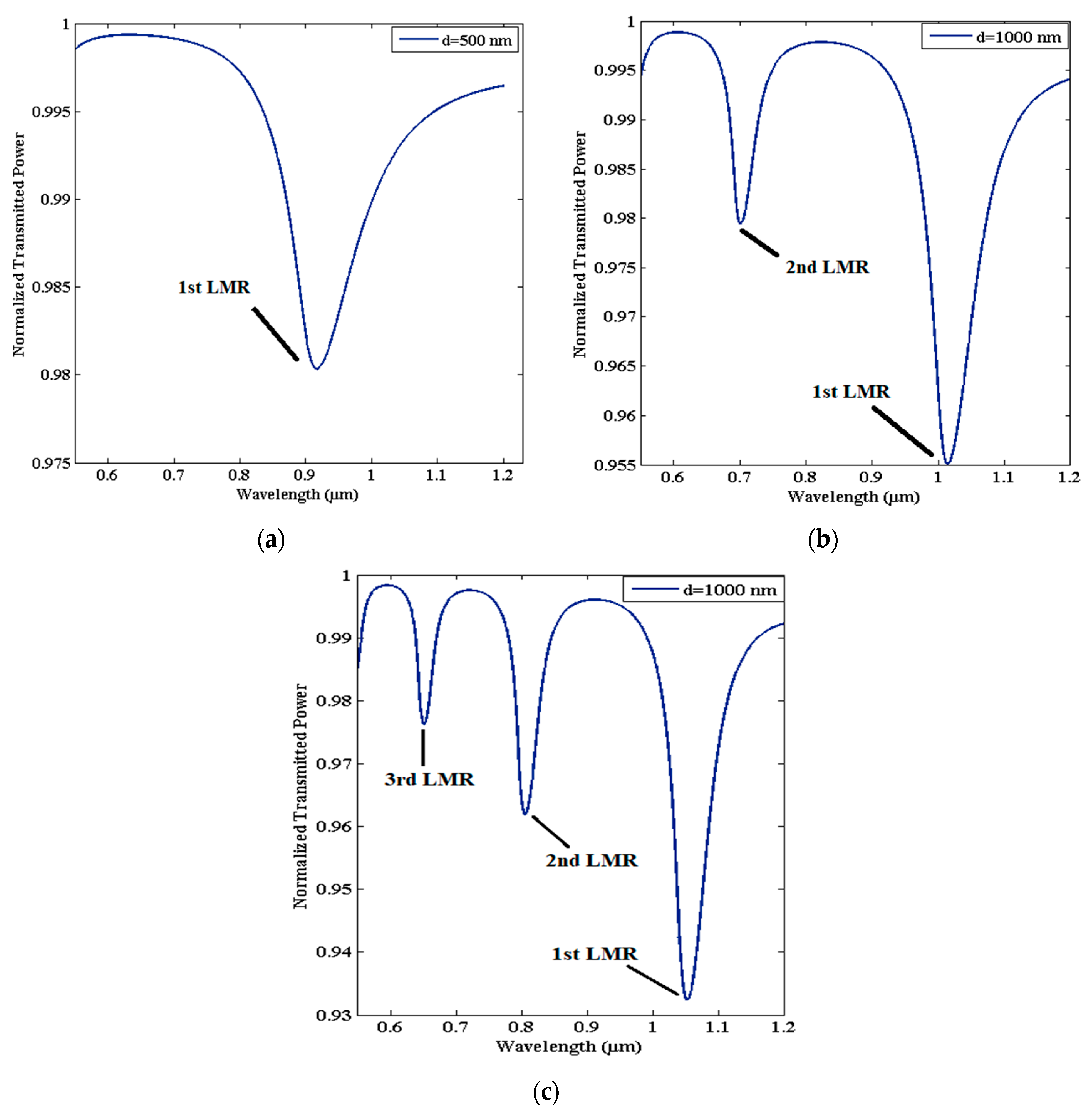
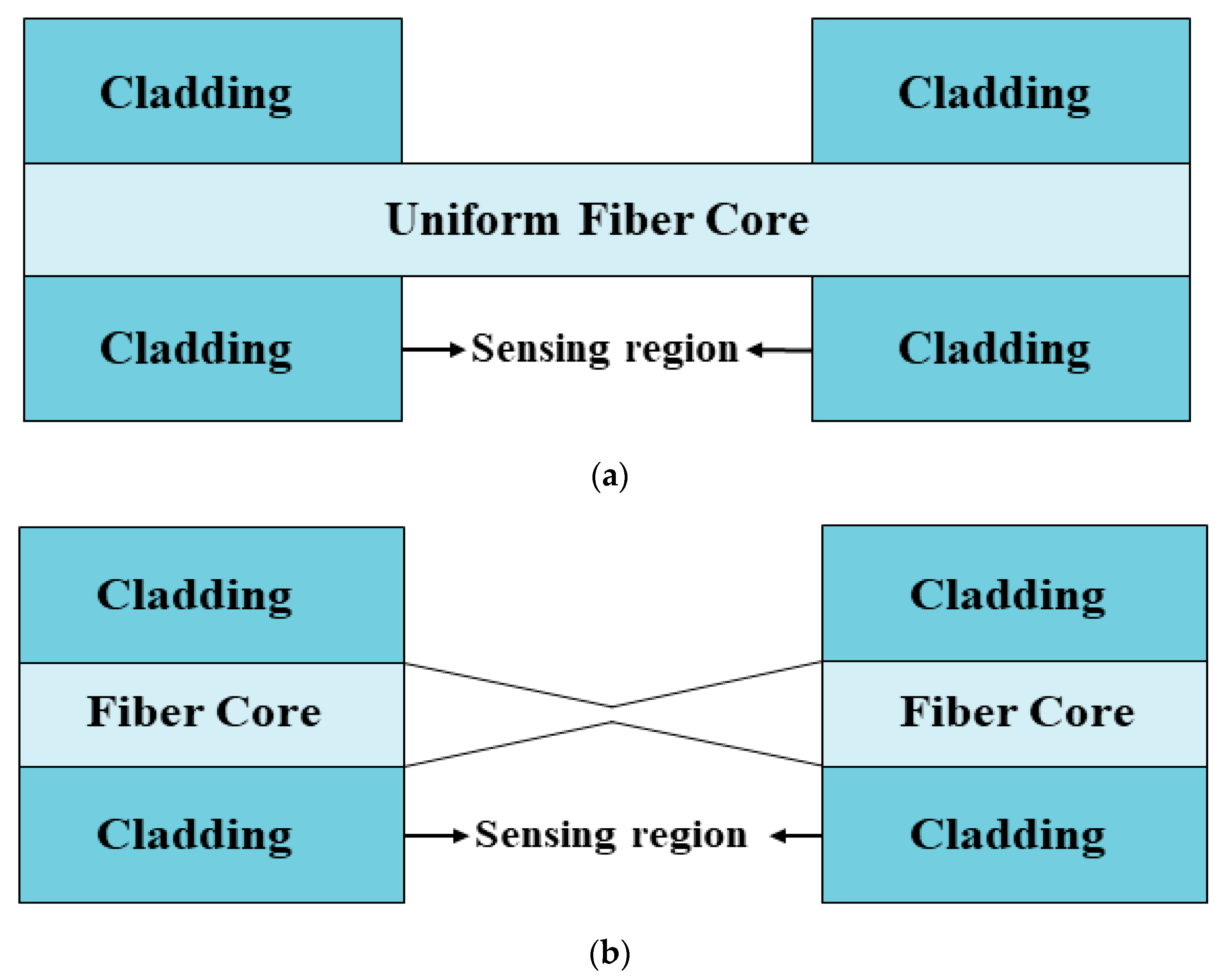

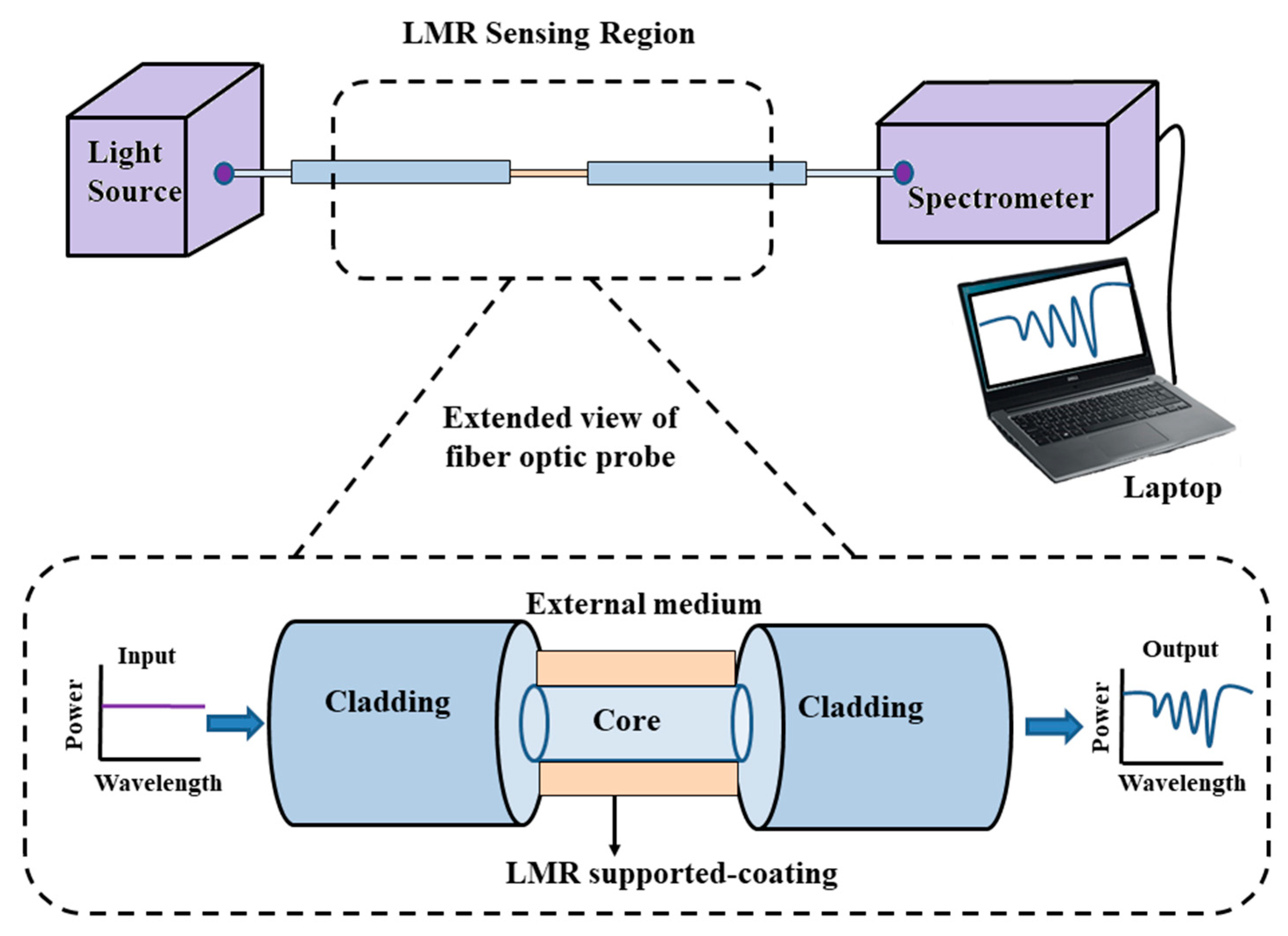

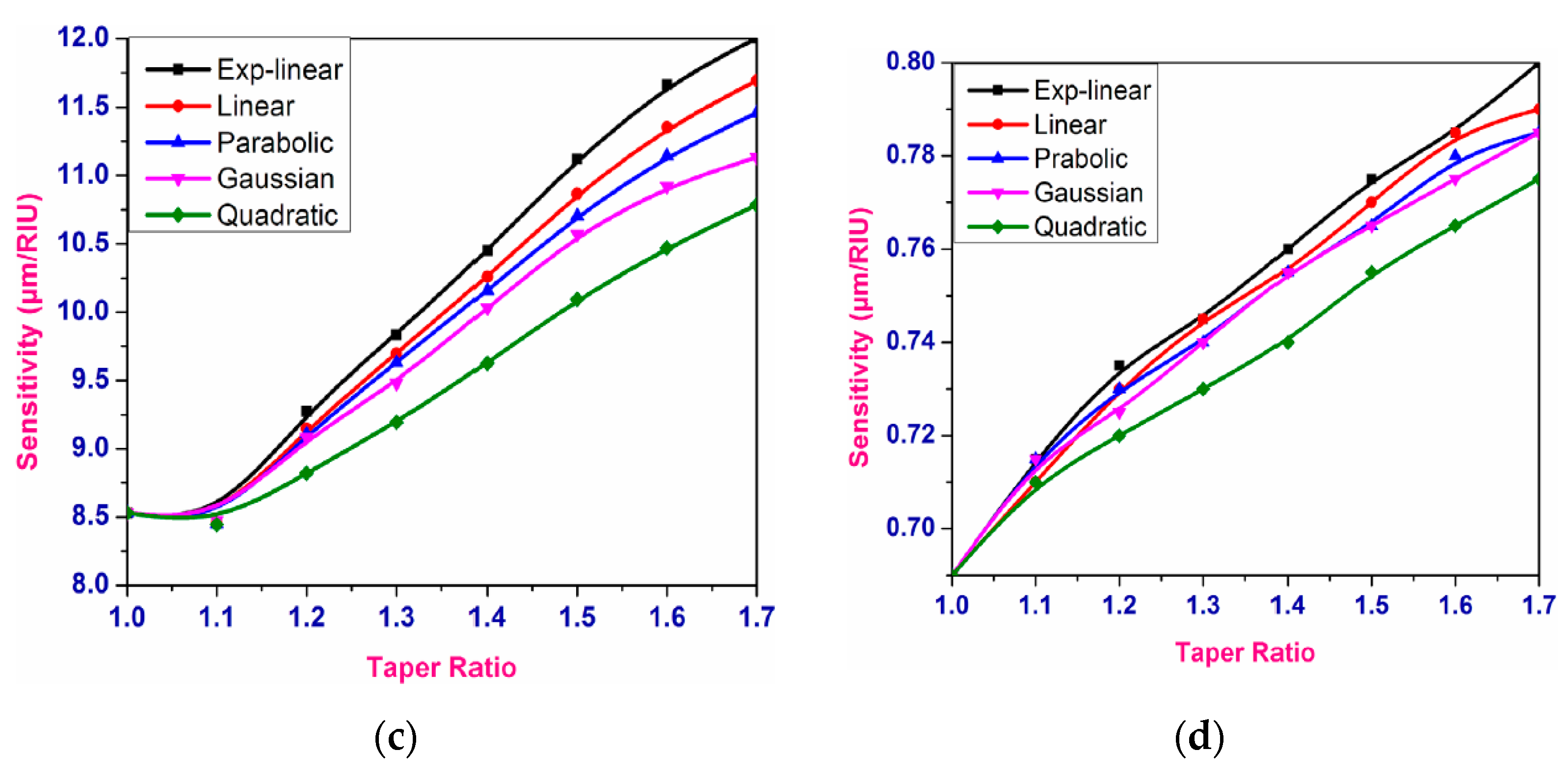
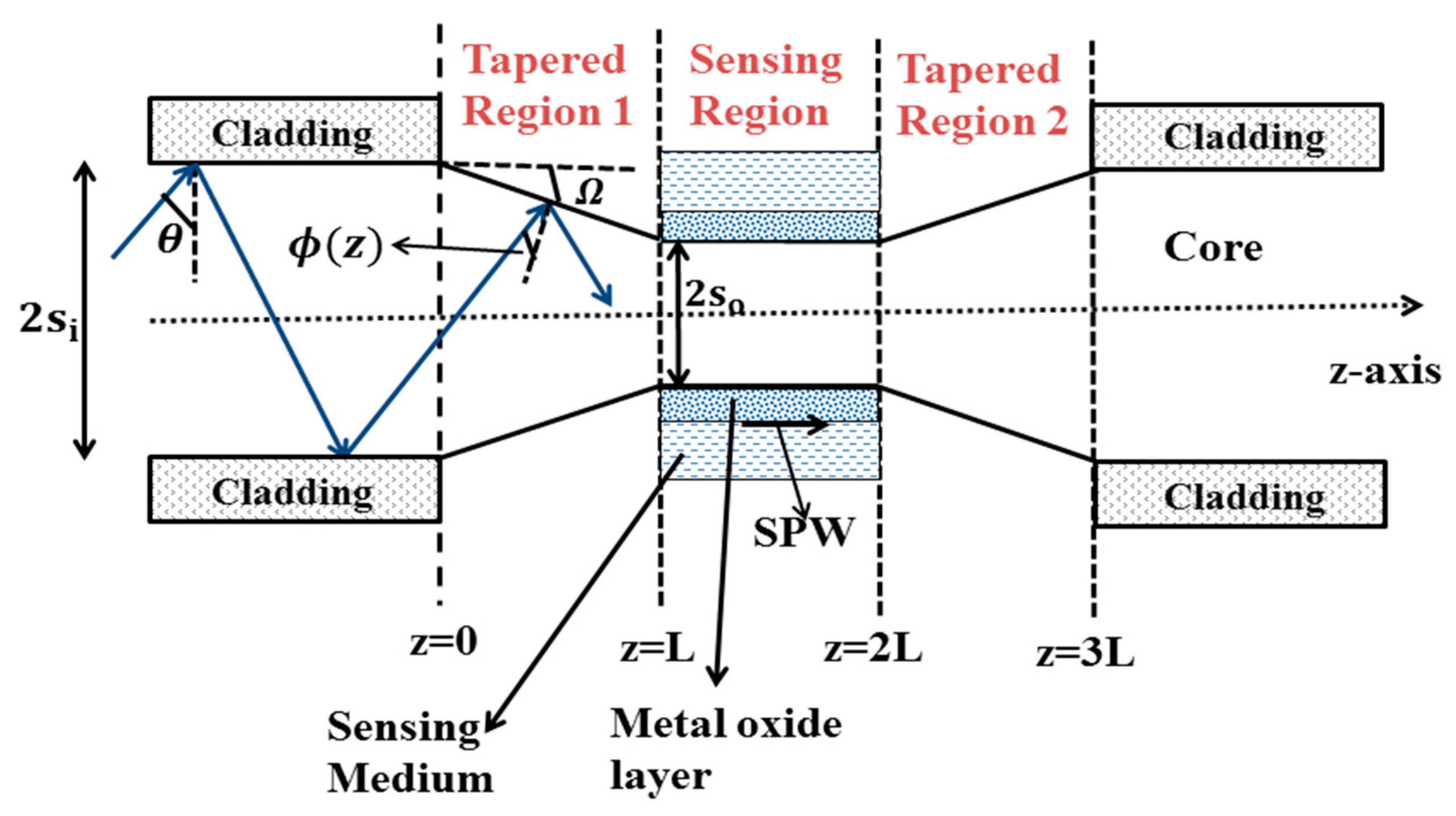
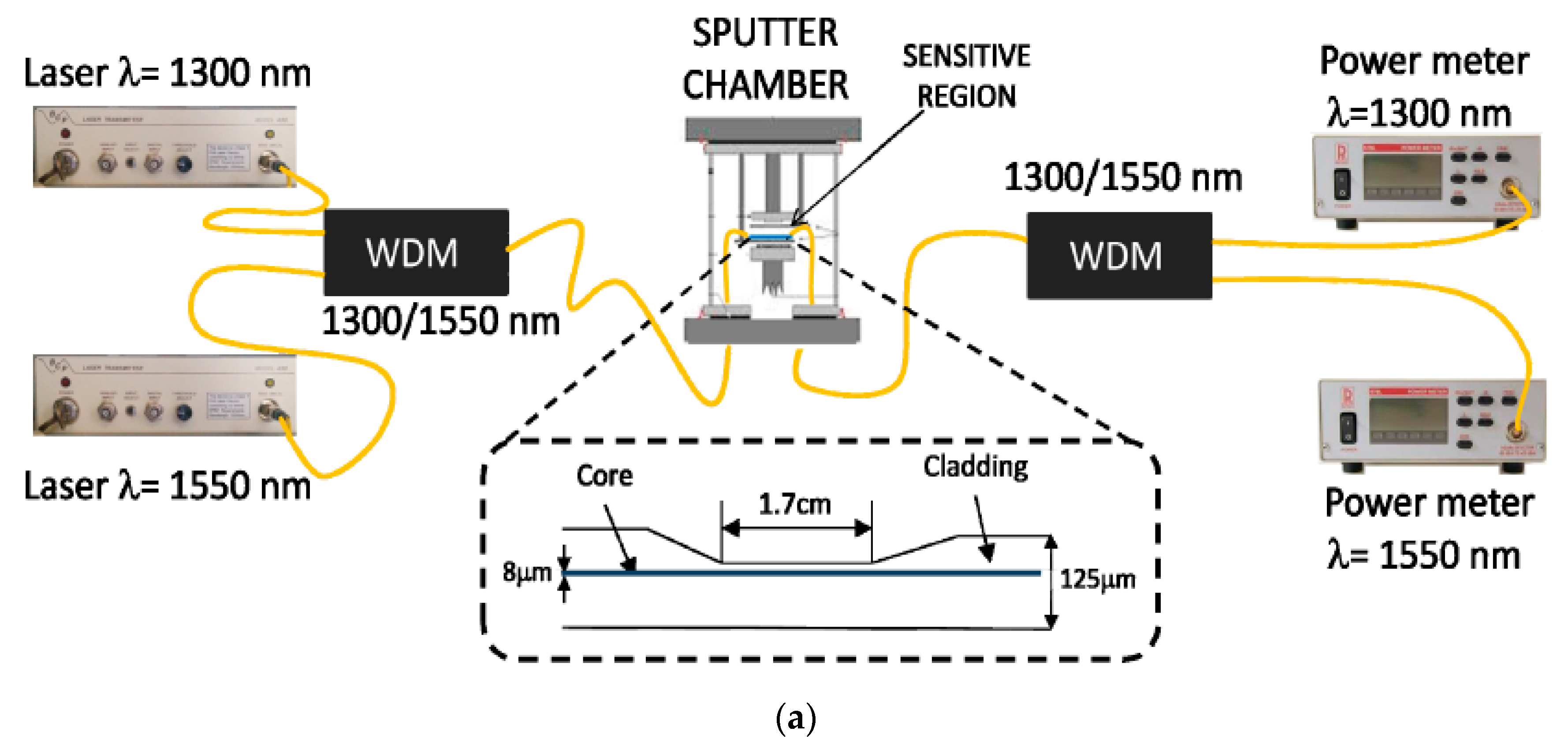

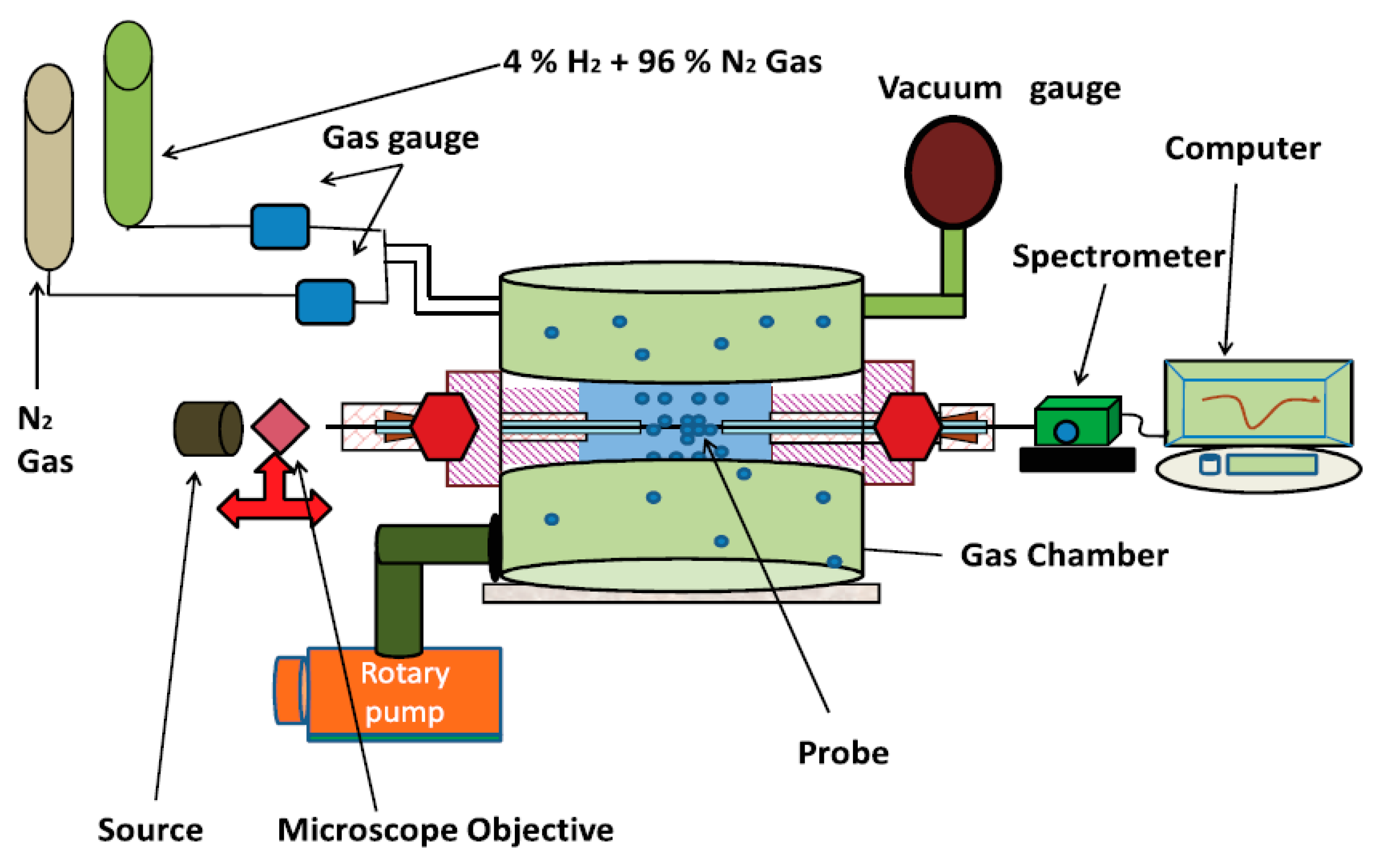
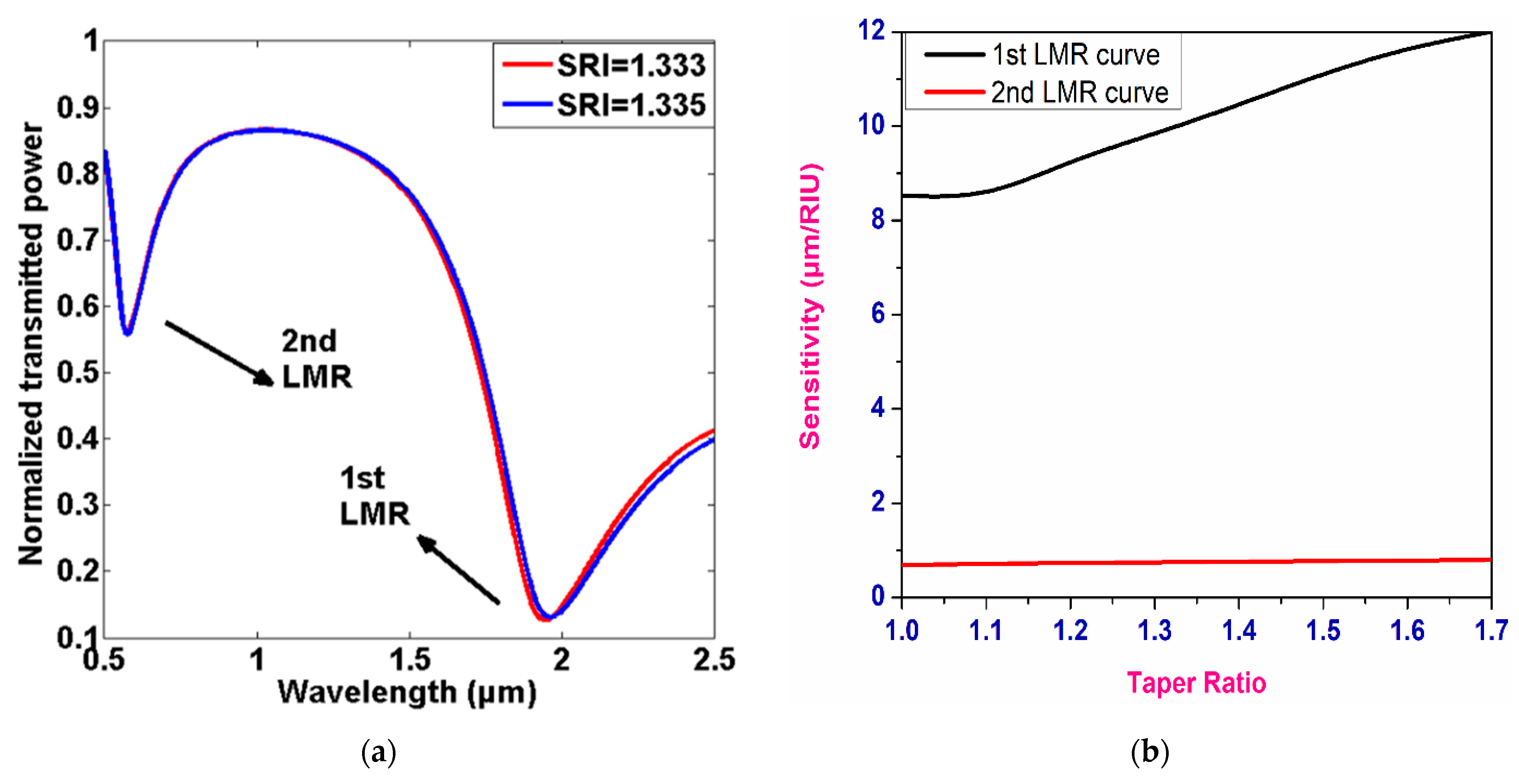
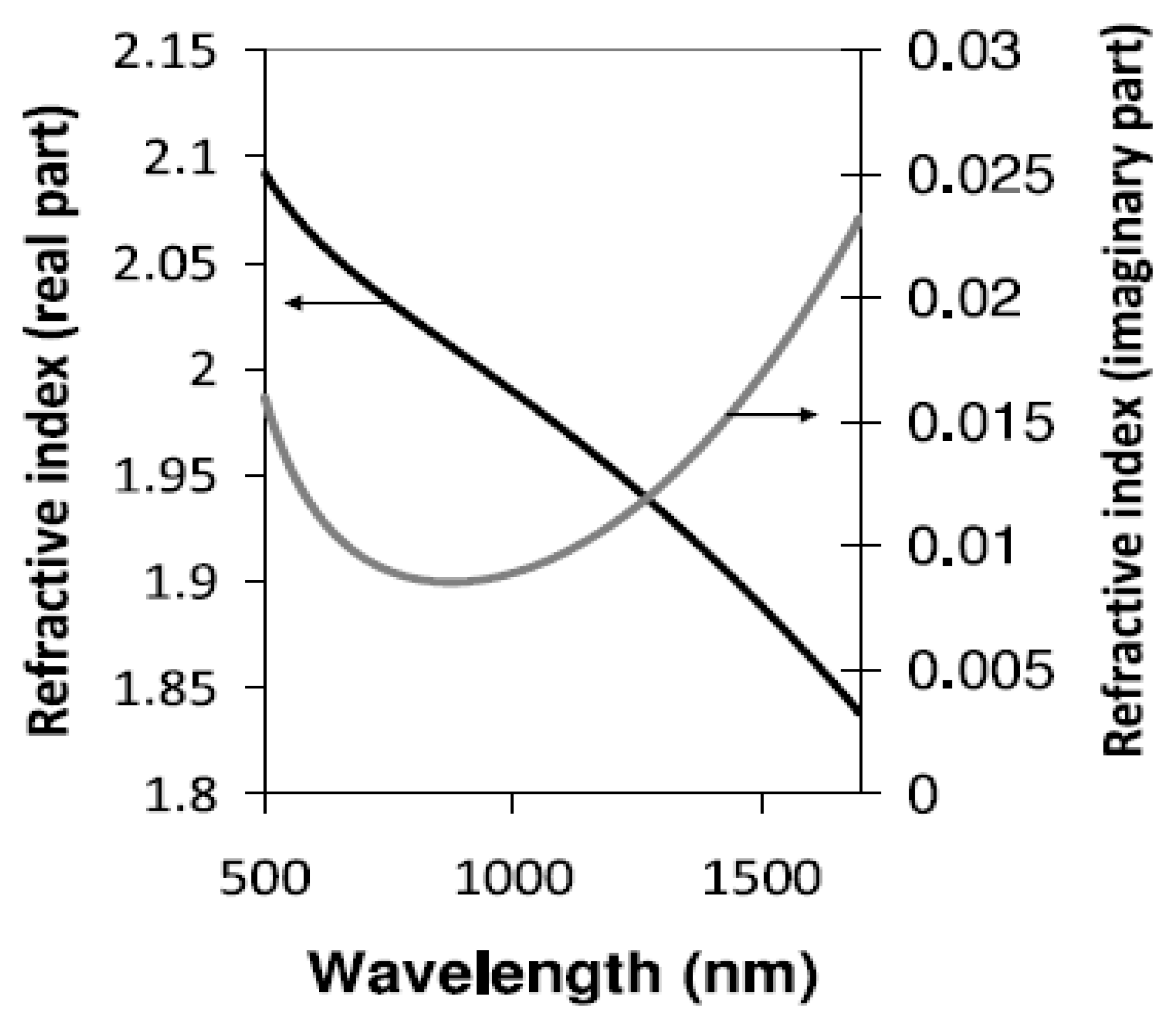
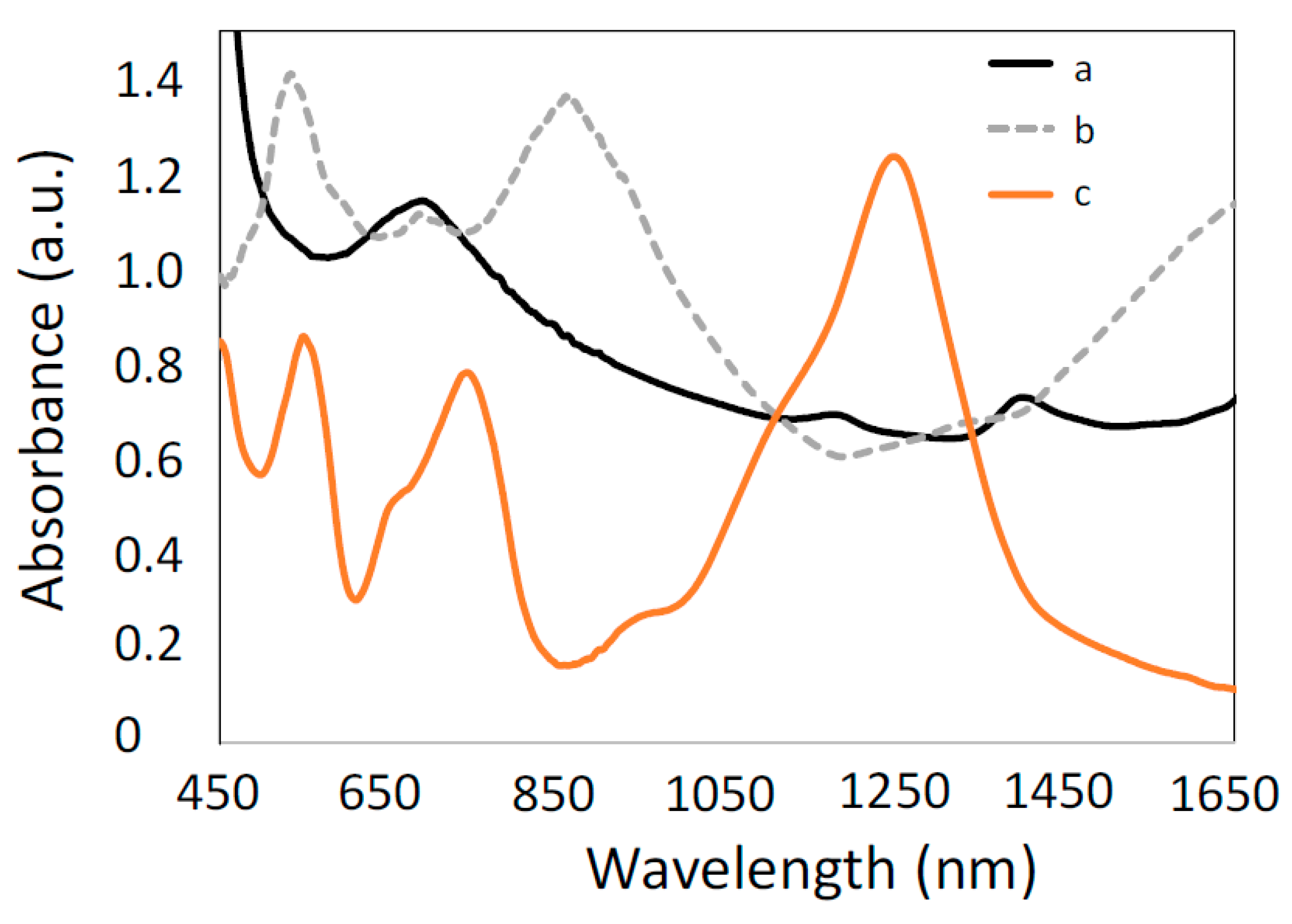
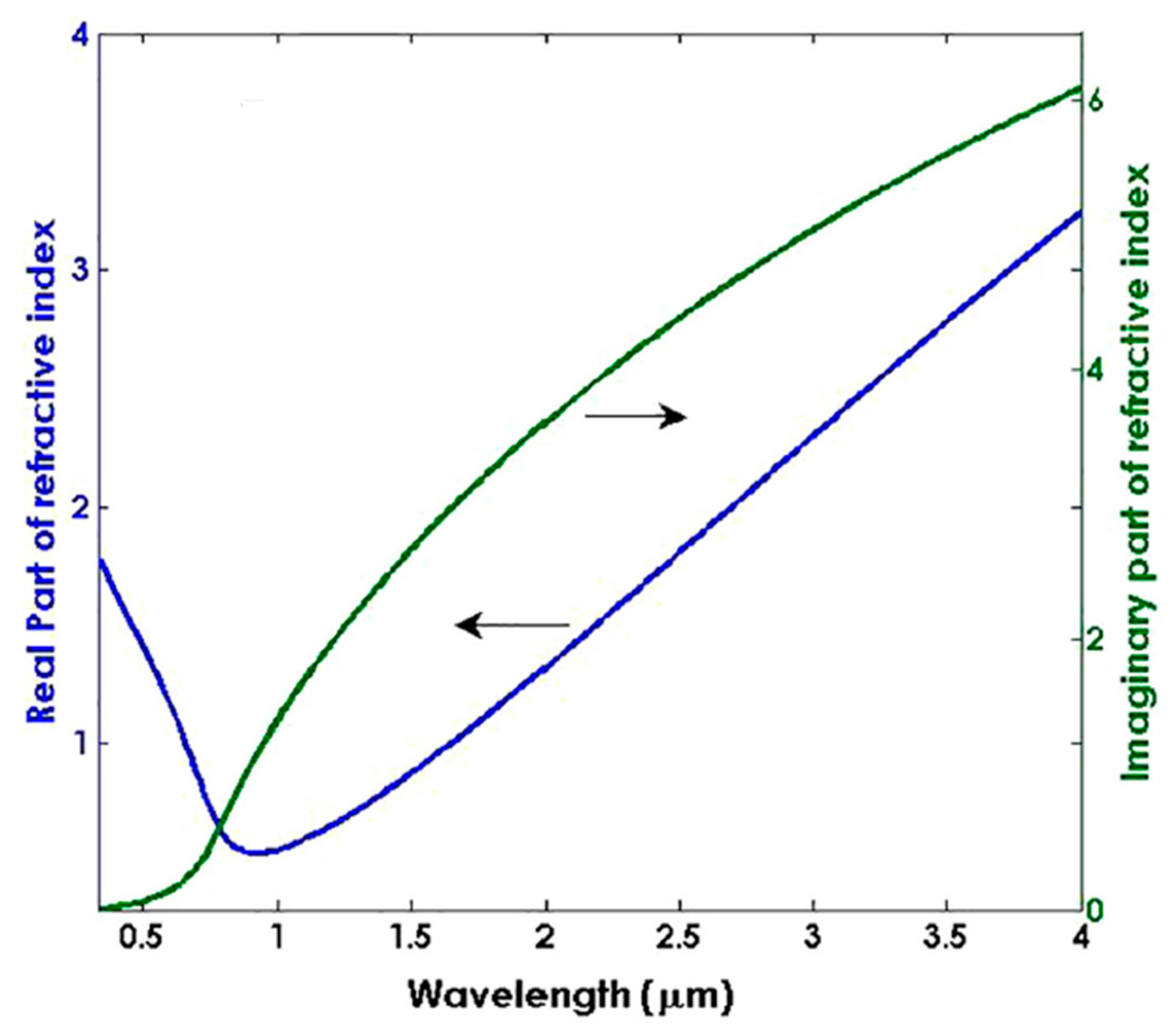
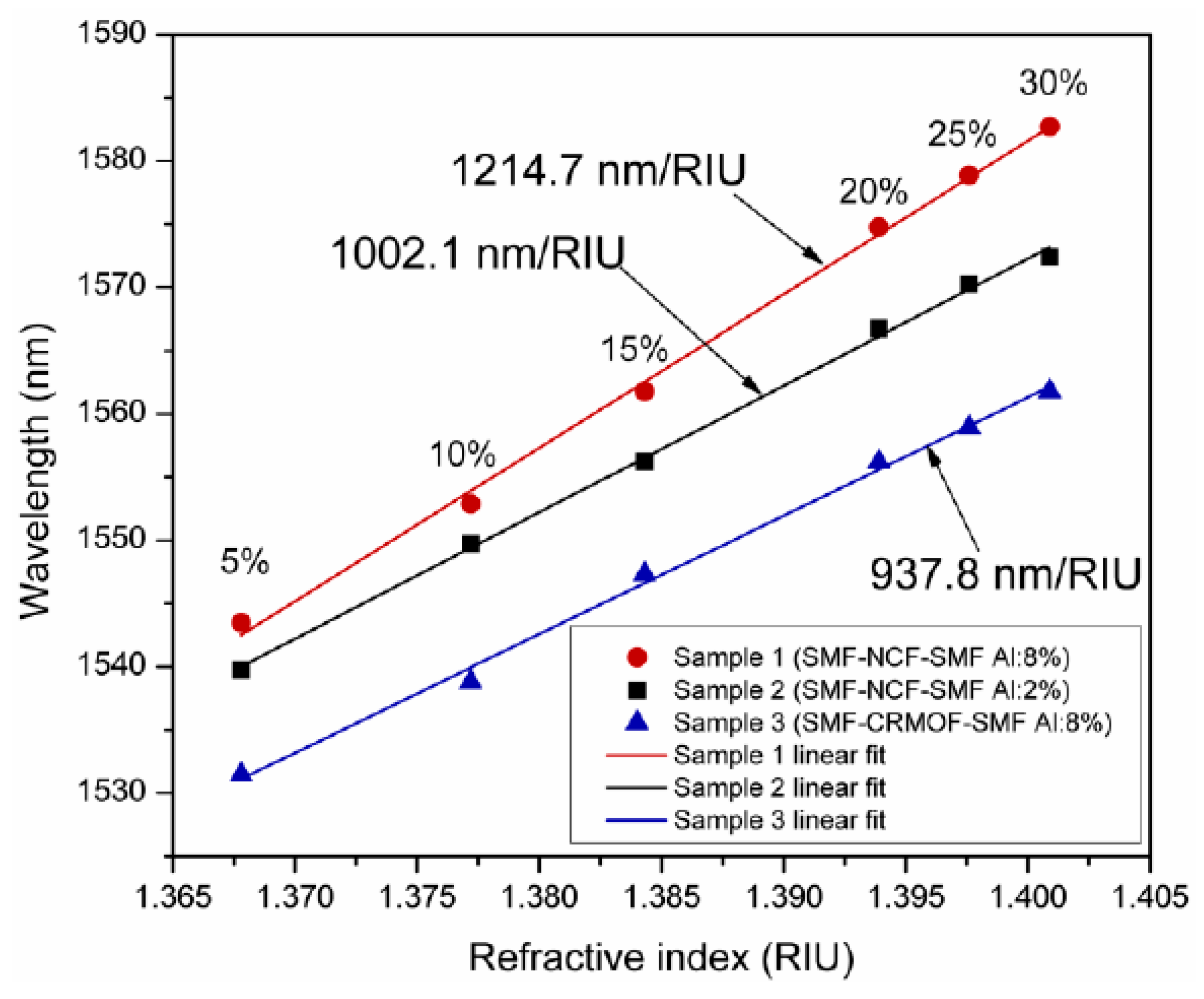

| Type of Resonance | Resonance Conditions |
|---|---|
| Surface plasmon resonance (SPR) | |
| Lossy mode resonance (LMR) |
| Fiber Configuration | Type of Study | Coated Material | Sensing Parameter | Range of RI | Maximum Sensitivity | Spectral Range (nm) | Ref. |
|---|---|---|---|---|---|---|---|
| 200 µm CRMOF | Experimental | ITO | RI | 1.321–1.436 | 3125 nm/RIU | 900–1500 | [38] |
| 200 µm CRMOF | Experimental | ITO and PAA–PAH | RH | 1.32–1.40 | 0.833 nm/%RH | 500–1700 | [99] |
| 200 µm CRMOF | Experimental | ITO and PVDF and ITO | Voltage | - | 0.4 nm/V | 500–1000 | [100] |
| 400 µm CRMOF | Experimental | ITO | Voltage | 1–1.4296 | 10 mVs−1 | 400–900 | [101] |
| 600 µm CRMOF | Experimental | ITO and ITO NPs | H2 gas | - | 0.71 nm/ppm | 350–700 | [57] |
| 200 µm CRMOF | Experimental | IT/SnO2 | Turbine oil | - | 0.27 × 10−3 nm/h | 1000–1700 | [110] |
| 400 µm CRMOF | Experimental | ITO | Ketoprofen | - | 1400 nm/M | 400–1000 | [111] |
| Tapered | Theoretical | ITO/AZO | RI | 1.33–1.34 | 12,005 nm/RIU | 500–2500 | [74] |
| 200 µm CRMOF | Experimental | In2O3 | RI | 1.333–1.392 | 4068 nm/RIU | 500–1700 | [113] |
| 200 µm CRMOF | Experimental | In2O3 | RI | 1.32–1.37 | 4926 nm/RIU | 400–1700 | [39] |
| 200 µm CRMOF | Experimental | In2O3 and PAH–PSS | RH | 1.32–1.40 | 0.935 nm/%RH | 500–1700 | [99] |
| 200 µm CRMOF | Experimental | In2O3 | RI | 1.332–1.407 | 5680 nm/RIU | 400–1700 | [114] |
| 600 µm CRMOF | Experimental | In2O3 | RI | 1.33–1.39 | 2937 nm/RIU | 400-700 | [115] |
| 600 µm CRMOF | Experimental | ZnO and ZnO NPs | H2S gas | - | 1.49 nm/ppm | 400–1000 | [43] |
| 600 µm CRMOF | Experimental | ZnO and ZnO nanorods | H2S gas | - | 4.14 nm/ppm | 350–650 | [116] |
| 600 µm CRMOF | Experimental | ZnO and ZnO–PPY | Cortisol | - | 12.86 nm/log | 350–900 | [51] |
| U-shaped | Theoretical and Experiment | ZnO | RI | 1.33–1.42 | 900 nm/RIU | 350–500 | [76] |
| 600 µm CRMOF | Experimental | ZnO and MoS2 | Urinary p-cresol | - | 11.86 nm/µM | 300–700 | [83] |
| CRMOF | Theoretical | ZnO and HfO2 | Pressure | 1.33–1.45 | 2 µM/MPa | 400–1000 | [117] |
| SM-MM-SM | Experimental | AZO | RI | 1.365–1.40 | 1214.7 nm/RIU | 400–2500 | [118] |
| 200 µm CRMOF | Experimental | AZO | RI | 1.33–1.45 | 2280 nm/RIU | 450–900 | [67] |
| 200 µm CRMOF | Theoretical and Experiment | TiO2 and PSS | RI | 1.33–1.43 | 2872.73 nm/RIU | 400–1500 | [40] |
| 200 µm CRMOF | Theoretical and Experiment | TiO2 and PSS | RI | 1.321–1.421 | 4000 nm/RIU | 400–1500 | [119] |
| CRMOF | Theoretical | ITO and TiO2 | RI | 1.331–1.436 | 23,000 nm/RIU | 400–2000 | [120] |
| Tapered | Theoretical | AZO and TiO2 | RI | 1.34–1.45 | 9000 nm/RIU | 400–800 | [72] |
| 200 µm CRMOF | Experimental | TiO2 and PSS | RH | - | 3.54 nm/%RH | 1150–1650 | [121] |
| Tapered | Experimental | TiO2 and Porphyrin | NH3 | - | 10,000 nm/ppm | 600–1000 | [73] |
| D-shaped | Experimental | TiO2 | RI | 1.333–1.398 | 4122 nm/RIU | 900–1700 | [122] |
| D-shaped | Theoretical | TiO2 and HfO2 and Rubber Polymer | RI | 1.33–1.39 | 67,000 nm/RIU | 600–2000 | [123] |
| Etched SMF | Theory + Experiment | SnO2 | RH | - | 1.9 nm/%RH | 1300–1700 | [55] |
| 200 µm CRMOF | Experimental | SnO2 | RI | 1.33–1.41 | 5390 nm/RIU | 450–1650 | [42] |
| D-shaped | Experimental | SnO2 | RI | 1.441–1.449 | 106 nm/RIU | 1150–1650 | [124] |
| CRMOF | Experimental | SnO2 NPs and α-Fe@Sn CS | Arsenite | - | 1.31 nm/µgL−1 | 350–650 | [125] |
| MM-coreless-MM | Experimental | SnO2 | IgG | - | 0.6 mg/L | 400–1600 | [126] |
| 200 µm CRMOF | Theory + Experiment | PAH–PAA | pH | - | 36.67 nm/pH, pH = 3 to 6 | 400–1000 | [127] |
| 200 µm CRMOF | Experimental | PAH–PAA and AuNPs | pH | - | 67.35 nm/pH, pH = 4 to 6 | 450–1000 | [49] |
| 200 µm CRMOF | Experimental | PAH–PAA and AgNPs | RH | - | 0.0943 nm/%RH | 400–1100 | [128] |
| 200 µm CRMOF | Experimental | PAH–PAA | RH | - | 0.56 nm/%RH | 500–800 | [129] |
| 200 µm CRMOF | Experimental | PAH–GNR@PSS | RH | - | 11.2 nm/%RH | 400–1000 | [130] |
| D-shaped | Experimental | IGZO | Salinity | - | 0.8 nm/SU | 900–1700 | [56] |
| D-shaped | Experimental | IGZO | RI | 1.39–1.42 | 12929 nm/RIU | 1150–1650 | [80] |
| 200 µm CRMOF | Experimental | GO–PEI | RI | 1.33–1.42 | 12460 nm/RIU | 400–900 | [131] |
| 200 µm CRMOF | Experimental | CuO | RI | 1.3335–1.4075 | 7324 nm/RIU | 400–1550 | [132] |
| 400 µm CRMOF | Experimental | ZrO2 | RI | 1.41–1.43 | 880 nm/RIU | 400–900 | [133] |
Publisher’s Note: MDPI stays neutral with regard to jurisdictional claims in published maps and institutional affiliations. |
© 2022 by the authors. Licensee MDPI, Basel, Switzerland. This article is an open access article distributed under the terms and conditions of the Creative Commons Attribution (CC BY) license (https://creativecommons.org/licenses/by/4.0/).
Share and Cite
Vikas; Mishra, S.K.; Mishra, A.K.; Saccomandi, P.; Verma, R.K. Recent Advances in Lossy Mode Resonance-Based Fiber Optic Sensors: A Review. Micromachines 2022, 13, 1921. https://doi.org/10.3390/mi13111921
Vikas, Mishra SK, Mishra AK, Saccomandi P, Verma RK. Recent Advances in Lossy Mode Resonance-Based Fiber Optic Sensors: A Review. Micromachines. 2022; 13(11):1921. https://doi.org/10.3390/mi13111921
Chicago/Turabian StyleVikas, Satyendra Kumar Mishra, Akhilesh Kumar Mishra, Paola Saccomandi, and Rajneesh Kumar Verma. 2022. "Recent Advances in Lossy Mode Resonance-Based Fiber Optic Sensors: A Review" Micromachines 13, no. 11: 1921. https://doi.org/10.3390/mi13111921







